Text and photographs : Usha Hariprasad
Bangalore, the garden city as it popularly known is quite ancient. A 9th century Begur inscription has the record of Bengaluru. The hero stone found in the premises of the Begur Nageshwara temple mentions the death of a son and servant of Begur chieftain Nagattara in the 890 AD battle of Bengaluru. After that the city finds mention as the headquarters of Yelhanka rulers or rather Yelhanka Nadaprabhus. They were chiefs who were subordinate to the Vijayanagara Empire. Kempe Gowda, one of the rulers built a town and erected a fort in 1537. This today is the Pete or Avenue Road area in Bangalore which is home to a multitude of traders and their wares. Kempe Gowda further went on to beautify the city, built temples and water bodies.
The story does not end here. The city then saw a series of conquests and transfer of powers who left their own imprint on the city.
In 1637 the city was captured by Bijapur army and became the jagir of Shahaji Raje, father of the great Maratha warrior Chhatrapati Shivaji. In 1687 it went into the hands of the Mughal army and from there it was leased to the ruler of Mysore – Chikkadevaraya Wodeyar. He developed the city, built another fort besides the old fort of Kempegowda.
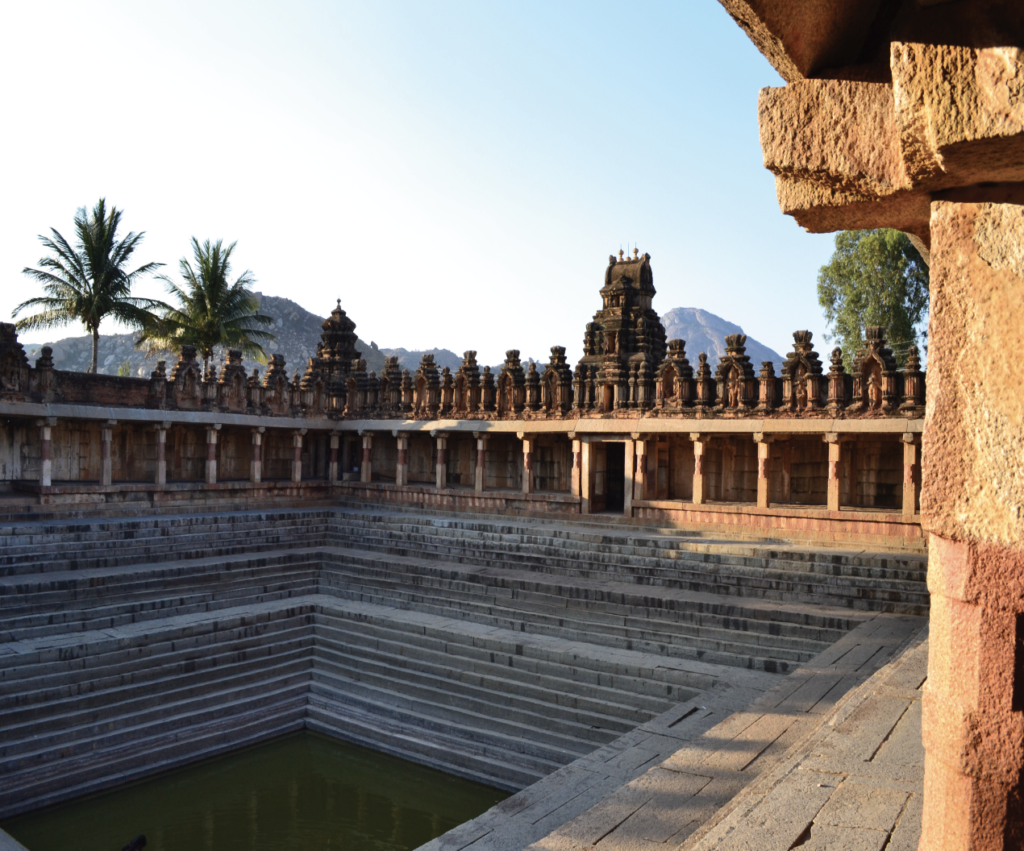
After Chikkadevaraya Wodeyar, Bangalore then went into the hands of Hyder Ali, who was the commander of Mysore army and from him to his son Tipu Sultan. The British defeated Tipu Sultan in 1799 in the fourth Anglo Mysore war. Though they gave back Mysore to the Wodeyars, they set up their cantonment in Bangalore. There were two cities within the 19th century Bangalore – one was the old Pete area of Bangalore and the other was the newer cantonment.
In 1831 the British took over the reins of Mysore administration from Wodeyars. The reason given was maladministration of Mysore region by the then Mysore ruler Krishnaraja Wodeyar III. However, they handed the control back to Mysore Wodeyars in 1881.
After India`s independence, both the old Bangalore city and Bangalore cantonment merged to form Bangalore City Corporation. From 1956, Bangalore became the capital of Karnataka.
Weekend destinations from Bangalore
Situated at 3000 feet above sea level, Bangalore has a pleasant climate throughout the year. It is surrounded by rocky outcrops and hill ranges. Many of the hills have been fortified and beautiful temples have been built. Various dynasties like Gangas, Hoysala, Vijayanagara dynasties have added tanks, forts and watch towers. The hills have thus become hot tourist destinations some offering great hiking opportunities and some serving as picnic spots. Here are seven such destinations from Bangalore that serve as good weekend getaways.
Channarayanadurga – A historical fort, ruins and a lake
Channarayanadurga is around 98 kilometers from Bangalore. It is en-route Madhugiri. It is a lovely getaway from Bangalore with a ruined fort, temple and a lake. The hill rises around 3734 feet and is fortified. The fortress is said to have been built around middle of 17th century by a chief Channapa Gauda from Madhugiri. It was with his family for several years before it was captured by the Marathas. Later it went into the hands of a Mysore general Komaraiya and later to Hyder Ali. It was again recaptured by the Marathas under Madhava Rao and later by Tipu Sultan.
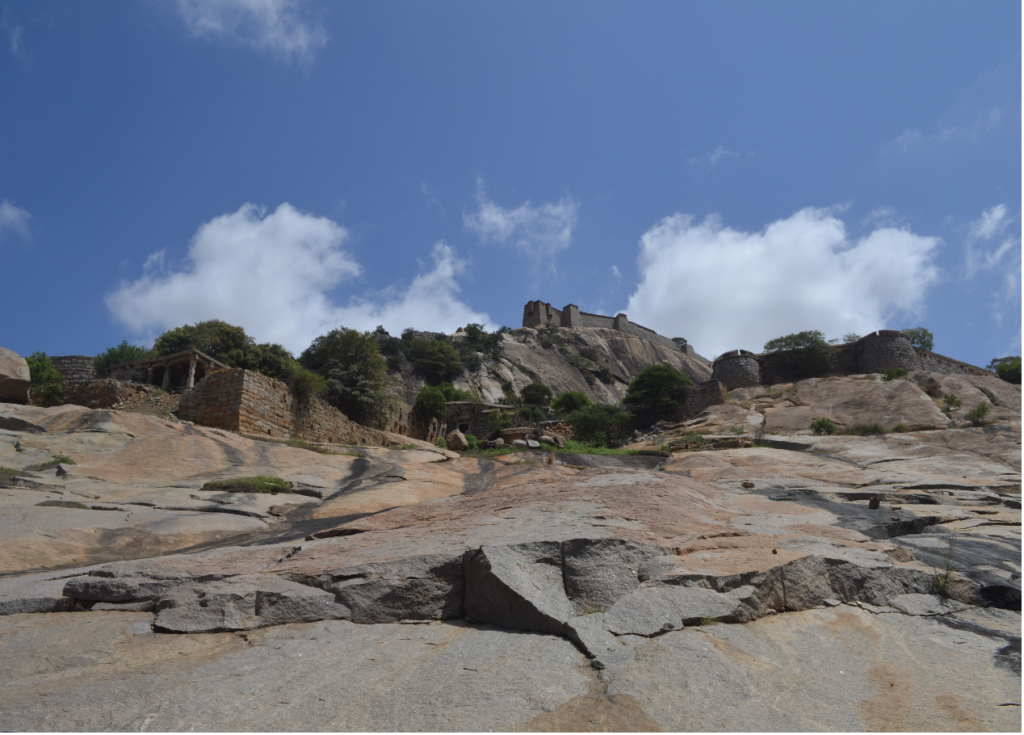
It is a great spot for trekking. The trek up the hill takes a good 1-1.5 hours. The best thing about this trek is reaching the fort. It has multiple entrances to confuse you. And as there are no markings or steps it takes time to figure the right entrance to the fort.
The beginning of the trek is through a village. Initially there is a bit of climb, but no rope or railings to guide you. After the initial 30 minute climb the trek is gradual. Look out for a lake and a ruined temple. Behind the ruined temple is your trek path to take you atop the hill fortress. Follow the path until you reach a spot from where two paths diverge. Take the one on the right. Though the left feels easier it is a fake pathway as there is no entrance to the fort from here. Trekking upwards the right path you will find the entrance of the fort tucked in a corner. This will take you to the top. The view from the top is glorious as it gives a panoramic view of the surroundings.
The descent takes a mere 45 minutes. Carry a water bottle and snacks with you as there are no shops nearby. Except for the initial steep climb, the trek is easy.
Chandragiri – Jain monuments
Chandragiri is around 144 km from Bangalore and is a popular pilgrimage site for Jains. There are around 14 Jain basadis (place of worship) here.
Chandragiri Hill is around 3049 feet high and some of the famous basadis here are Chandragupta Basadi, Kattale Basadi and Saavati Gandhavarana Basadi. The basadis are dedicated to the 24 Jain Tirthankaras. There is a basadi dedicated to Bahubali or Gomateshwar and then there is Chandragupta Basadi that is dedicated to Parshvanatha, the 23rd tirthankara. It is one of the oldest basadis here. There are frescoes inside the basadi that details the life and times of Mauryan King Chandragupta. There is also a Chavundaraya Basadi dedicated to Neminatha – the 22nd Tirthankara and that was built by a Ganga minister Chavundaraya. There is also a cave dedicated to saint Bhadrabahu who was the guru of Chandragupta.
The hill abounds in inscriptions – some engraved on rock, some in pillars protected by mandapa like structures. Most of these are located from south-west to north-east of Chandragupta basadi. Some are hero stones, while some talk about Jain monks and their self-starvation or sallekhana vows to achieve nirvana and some are about Hoysala queen Shantala. Near Chandragiri hill is the Indragiri hill that has the famous statue of Gomateshwara. The 58-foot tall statue of Gomateshwara was installed by Chavundaraya in 982 AD. The anointment of Gomateshwara statue takes place every 12 years and draws a huge number of devotees.
Devarayanadurga – trek and temples
The place is around 73 km from Bangalore and boasts of Narasimha temples. Devarayanadurga is known by various names like Anebiddasari, Jadakana Durga after a chief and also Karigiri – Elephant Hill. The hill was captured by the Mysore King Chikkadevaraya sometime in 1696 and hence the name Devarayanadurga.
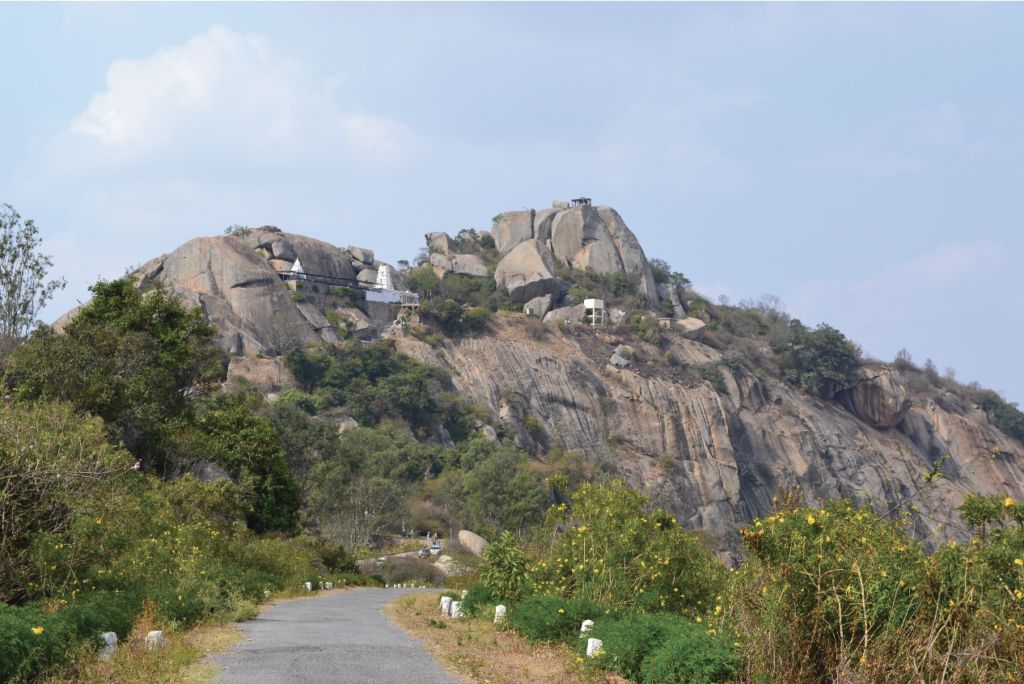
Situated at an altitude of 3940 feet it is famous for its temples. At the base of the village is the Dravidian style Lakshmi Narasimha temple. It was built by the early Wodeyar ruler Kantirava Narasaraja. The tower however was repaired in 1858 by Krishnaraja Wodeyar III. Atop the hill is Yoga Narasimha temple. It is a temple consisting of inner sanctum, a sukanasi, a navaranga and a front facing mukha mantapa. Adjacent to the temple are three water bodies – Narasimha teertha, Parashara teertha and Pada teertha. A cave nearby has the water source of Pada teertha. Higher up the hill there is a small temple dedicated to Garuda, the bird from Hindu mythology Ramayan. The hill also boasts of a cave temple of Rama near a spring Dhanush teertha. There is also a British style traveler’s bungalow and a bungalow meant for missionaries on the hill.
At a little distance from Devarayanadurga hill is a small spring Namada Chilume. A deer park and a 20 acre garden of medicinal plants are other attractions nearby.
Magadi – bastion of Kempe Gowda
Magadi is a small place near Bangalore – some 53 kilometers from the city. Once the capital of Kempe Gowda, it is now a nondescript village.
Kempe Gowda is said to be the founder of Bangalore. He had the vision to build Bangalore as a fortified city in the year 1537. He and his son Kempe Gowda II ruled the city for more than 100 years. However in 1638, with the attack by Bijapur army, Kempe Gowda -II was forced to give up Bangalore and move to Magadi and made it his capital. He built a fort, dug a moat around it and during his reign and his successors, two Magadi temples were built inside the fort complex. He not only fortified Magadi but also took precautions to fortify nearby hills like Savandurga and he captured other regions like Hulikal, Hulliyurdurga, Kunigal, Uttaridurga etc.
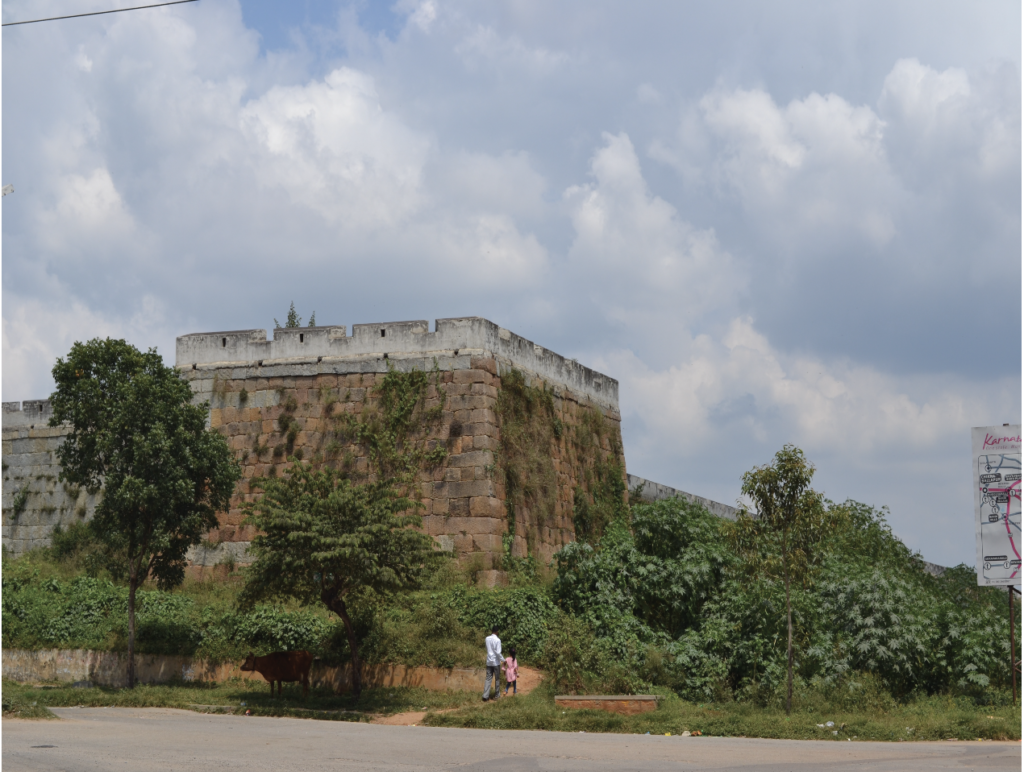
You can see traces of these in Magadi. You can see a small section of Magadi Fort. It has no watch towers, entrances or gateways. Nearby is the Magadi Rameshwara temple dedicated to Lord Shiva. Another famous temple is Someshwara temple constructed by the last of Kempe Gowda – Kempaveera Gowda in 1712. Kempaveera Gowda was taken prisoner in 1728 by Mysore King Dodda Krishnaraja’s Dalavayi, Devaraja. He died in the prison of Srirangapatna. The temple is a fine Dravidian structure. It has the idols of Someshwara or Shiva, a three feet high idol of Parvati and another image of Satyanarayana.
Another famous temple in Magadi is the 12th century Magadi Ranganathaswamy temple. The temple is dedicated to Lord Vishnu. The temple is a huge structure and it was expanded in stages by the later rulers like Hoysalas, Vijayanagaras and Wodeyars. The magnificent gopura of the temple was added only in 1959 by Jayachamarajendra Wodeyar.
Nijagal – Ruins of temple and a fort
The place is also known as Rasasiddhara betta or hill. It is located near Tumkur and is around 54 km from Bangalore.
Nijagal was witness to the famous battle between the Marathas and Hyder Ali vassal, Sardar Khan. The story goes something like this. Marathas were under the lordship of Madhava Rao Peshwa and they set out to defeat Hyder Ali. The idea was to conquer Mysore and en-route they stopped at Nijagal. The fort of Nijagal was not easy to surmount. It was high up, defended by steep boulders from all sides. It was secured by moats, watch towers and vigilant guards. The fort did not lack water as it had plenty of springs – Rasa Siddhara done, Kanchina done and Akka-Tangiyara done. Thus the Marathas could not easily capture the fort and the siege lasted nearly two months. It was then that the chieftain of Chitradurga – Madakari Nayaka aided the Marathas and the fort succumbed to the Marathas finally.

There are no charred remains of the battle though. The trek up the hill is pleasant and easy. It starts with a mud route initially .The trail is approximately four km. There are rocks and boulders en-route. Scattered cave shrines, numerous ponds, ruined temples greet you as you trudge up. It takes a good one hour to reach the top. The surrounding hillocks are visible from the top and there are ruins of fortifications as well. The place is suitable for a night trek as well.
Nijagal is popular with locals as there are temples dedicated to Narasimha and Veerabhadra. There is a spring here called Siddhara-done that houses a dargah, sacred to both Hindus and Muslims.
The landmark to locate this route on Bangalore-Tumkur highway is the Kamat Hotel and Café Coffee Day (CCD) on your left. Take the left after CCD and you will find a railway under bridge. Cross the track and you can find Nijagal betta.
Nandigrama: Temple of Bhoga Nandeeshwara
Nandigrama is near to the popular weekend getaway-Nandi Hills and is just 54 kilometers from Bangalore. A small section of British army was stationed from 1799-1809 in this village. But that’s not why this place is popular today. It houses the ancient Bhoga Nandeeshwara temple built in 9th century. The village Nandigrama has become famous because of this temple. The temple is a Dravidian style temple of 806 AD and built by Rathnavali queen of a Bana ruler. It is 320 meters in length and 250 meters in width. From outside it looks like a single temple. But it is actually three temples built at various intervals. The temple of Bhoga Nandeeshwara has been expanded by several later rulers – Chola, Hoysala and Vijayanagara rulers.

At one end is the temple of Arunachaleshwara. This temple of Shiva has an inner sanctum with the Linga, then ardhamantapa and then navaranga. It has a square shikara. In front of the temple is a Nandi mantapa. The Nandi is made of granite. This mantapa and the square shikara was constructed by son of Arunachaleshwara, an officer during the rule of Nolambas. There is a two feet idol of Simha Ganesh inside the shrine.
In the North you have the ancient temple of Bhoga Nandeeshwara built prior to 9th century. This temple too houses an inner sanctum, ardhamantapa and a navaranga. The pillars of navaranga are of Ganga style. In front of the temple there is another Nandi mantapa. The Nandi here is of black stone.
Wedged between the temples of Bhoga Nandeeshwara and Arunachaleshwara is a temple of Uma-Maheshwara. Shiva and Parvati are worshipped here. The temple houses a beautiful kalyana mantapa with minute sculpturing of parrots on the pillars. There are some 500 such figures on the pillars.
The temple courtyard boasts of smaller shrines for various goddesses – Kuchamba, Girijamba, Apeetha etc.
There is also a Vasantha mantapa for spring festivities built during Vijayanagara period. Also a small pond named Shringa teertha exists here with a temple dedicated to Shringeshwara. The pond is said to be the birth place of south Pinakini river.
Sivagange: cave temples and springs
Sivagange is 53 km from Bangalore and is a major trekking and pilgrimage center near Tumkur.
The hill is around 1368m high and is home to plenty of temples and springs. The ancient name of the hill was Kakudgiri. It is a conical shaped hill and has the famous temple of Gangadhareshwara. It is said that ghee turns to butter when applied to Gangadhareshwara in the temple. The temple has the idol of Kempe Gowda and is said to have been patronised by the same. This is the first temple you will encounter while you climb the hill.
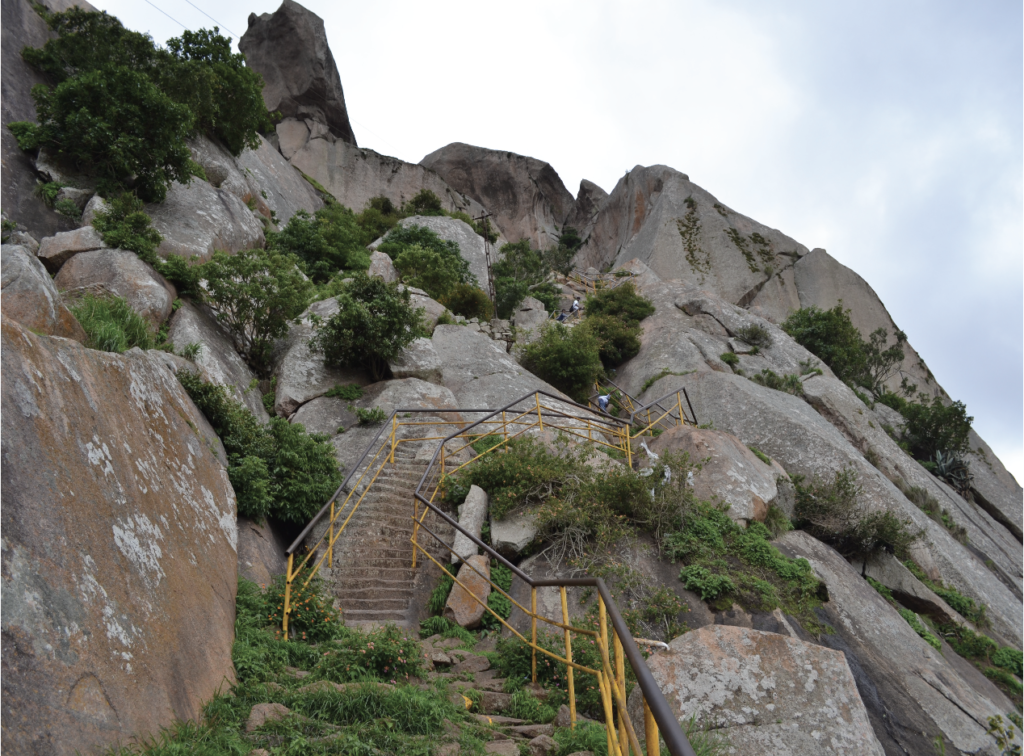
When you trek higher up the hill, watch out for Kempegowda Hazara – a structure with pillars built in Vijayanagara style. As you climb further up you are treated to many springs – Antara Gange, Patala Gange and so on. There is also an underground water spring Olakala teertha.
At the very top of the peak there is a Nandi statue. It is a monolith and has a small circular path for circumbulation. Atop is a placed known as Shantala drop. It is said to be the place where Queen Shantala, wife of Hoysala King Vishnuvardhan committed suicide. Some say that the queen killed herself as she was unable to produce an heir to the throne. However some refute this and say she undertook Sallekhana- self starvation to attain nirvana.
The trek up the hill takes 2-3 hours and is a 4.5 km trail. Steps, railings help you navigate the stretch easily. But beware of monkeys. They snatch away snacks, water bottle and sometimes caps. Best to pack it all in your backpack while trekking up the hill.
At the base of the hill there are some Mutts. One is the Sankara Mutt of Sringeri and then there is the Lingayat Mutt as well. No wonder the place is brimming with devotees during weekends. So if you wish for some peace and solitude visit this place during weekdays.

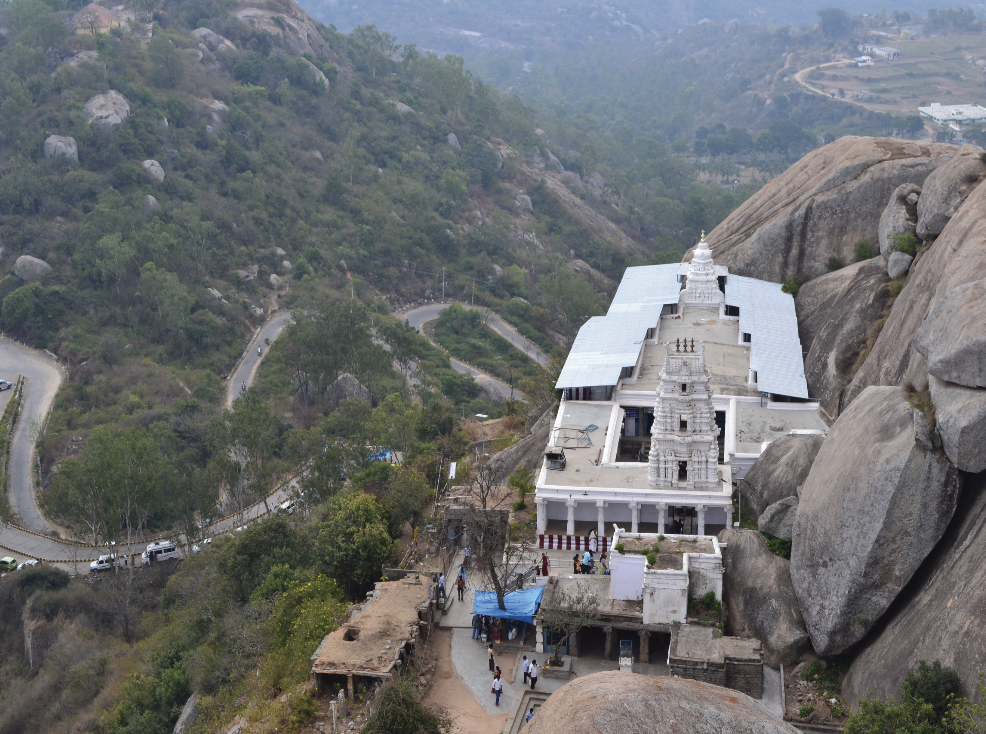
 [/column]
[/column]